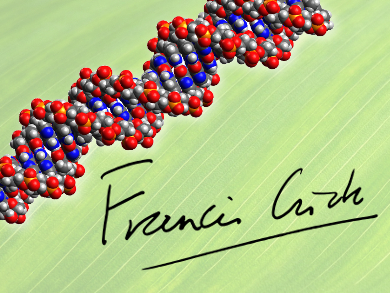Francis Crick was born on June 8, 1916, in Northampton, UK. He received his B.Sc. in physics from University College London (UCL), UK, in 1937, and started a Ph.D., working on measuring the viscosity of water at high temperatures. His work was interrupted by the outbreak of World War II, and he never finished the degree. His viscosity measurement apparatus was destroyed by a bomb during the Battle of Britain.
During the war, Crick worked as a researcher for the British Admiralty. He designed triggers for magnetic mines that could evade enemy minesweepers. After the war, his interest turned to biology. He was fascinated both by the mystery of life and the source of consciousness. In 1947, he joined the Strangeways Laboratory in Cambridge, UK, where he worked on the properties of cytoplasm. His background proved a good fit for the research: measuring the viscosity of cytoplasm using small magnetic particles.
In 1949, Francis Crick moved to the Cavendish Laboratory at the University of Cambridge to work on finding the structure of proteins using X-ray crystallography. There, he joined Max Perutz and John Kendrew, who would later receive the Nobel Prize in Chemistry in 1962 for their work on the structure of hemoglobin and myoglobin. During his time there, the α-helix structure in proteins was discovered. Crick co-developed a theory of the X-ray diffraction pattern a helical molecule would produce, which was useful for the famous discovery he made soon after: the structure of DNA.
In 1951, James Watson joined Cavendish Laboratory. Together, he and Crick discovered the double helix structure of DNA, which explained how genetic information could be passed on from generation to generation: the double helix “unzips”, and the complementary pairing of nucleobases allows the generation of a perfect copy.
Their discovery was based on X-ray diffraction results of DNA, which Watson and Crick had received from Maurice Wilkins. Wilkins was a personal friend of Crick who worked on DNA at the competing King’s College in London. The image (nicknamed “Photograph 51”) had been produced by Rosalind Franklin and her graduate student Raymond Gosling. There has been some controversy over the contribution of Franklin to the discovery, since the picture had been passed on without her knowledge, and she was not included as a co-author by Crick and Watson.
Together, Francis Crick, James Watson, and Maurice Wilkins received the 1962 Nobel Prize for Physiology or Medicine “for their discoveries concerning the molecular structure of nucleic acids and its significance for information transfer in living material.”
After the discovery of the structure of DNA, in 1954, Crick finally finished his Ph.D. with a thesis on “X-Ray Diffraction: Polypeptides and Proteins”. He continued to work on the structure and synthesis of proteins. In 1956, he formulated the central dogma of molecular biology, which states that the information in DNA, via intermediate RNA, is responsible for the structure of proteins. He contributed to the discovery of the genetic code and correctly suggested that three nucleotides encode one amino acid.
In 1977, Crick left Cambridge and joined the Salk Institute for Biological Studies in La Jolla, CA, USA, where he turned to neuroscience and the origin of consciousness, the other big question besides the principles of life that interested him. He worked on the topic until his death on July 28, 2004.
Francis Crick is the answer to Guess the Chemist (54).
Sources
- Francis Crick: Discoverer of the Genetic Code,
Matt Ridley,
Harper Press, London, 2006.
ISBN: 978-0061148453 - Francis Crick – Biographical,
The Nobel Foundation, 1962.
Selected Publications
- The double helix: a personal view,
F. Crick,
Nature 1974, 248, 766–769.
DOI: 10.1038/248766a0 - General Nature of the Genetic Code for Proteins,
F. H. C. Crick, L. Barnett, S. Brenner, R. J. Watts-Tobin,
Nature 1961, 192, 1227–1232.
DOI: 10.1038/1921227a0 - The Structure of Collagen,
A. Rich, F. H. C. Crick,
Nature 1955, 176, 915–916.
DOI: 10.1038/176915a0 - Molecular Structure of Nucleic Acids: A Structure for Deoxyribose Nucleic Acid,
J. D. Watson, F. H. C. Crick,
Nature 1953, 171, 737–738.
DOI: 10.1038/171737a0 - Evidence for the Pauling–Corey α-Helix in Synthetic Polypeptides,
W. Cochran, F. H. C. Crick,
Nature 1952, 169, 234–235.
DOI: 10.1038/169234a0




